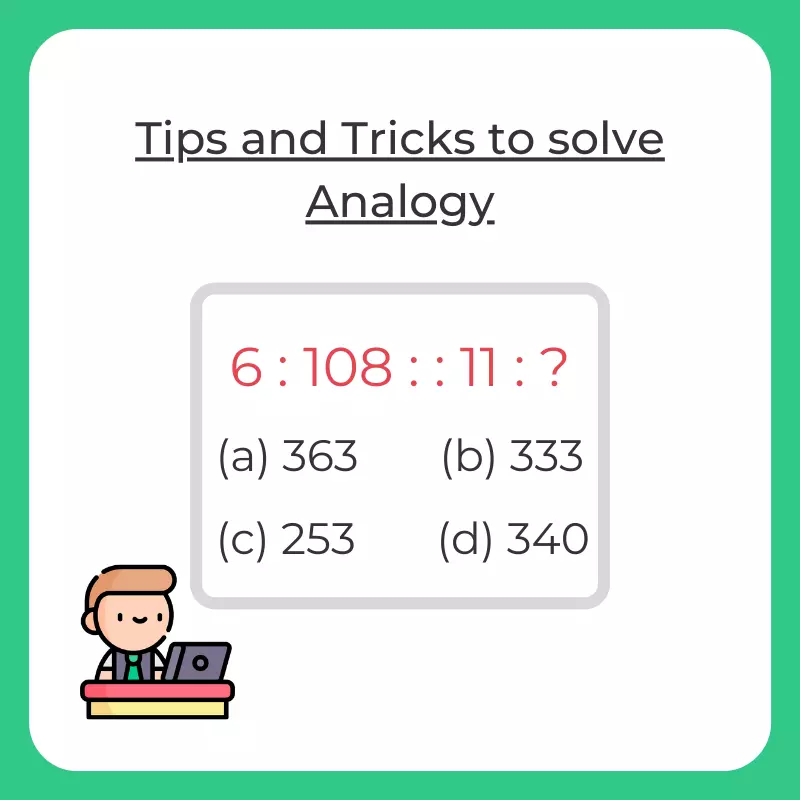Logical Menu
- Number Series
- Coding and Number Series
- Letter and Symbol Series
- Logical Sequence of Words
- Analogy and Classification Pattern
- Statements and Conclusions
- Statements and Assumptions
- Data Sufficiency
- Visual Reasoning
- Cube and Cuboid
- Cube
- Dice
- Directional Senses
- Blood Relations
- Odd Man Out
- Syllogism
- Arrangements
- Seating Arrangements
- Coding Deductive Logic
- Objective Reasoning
- Selection Decision Tables
- Attention to Details
- Inferred Meaning
- Cryprtarithmetic
- Get Off-campus Drive Updates
- Get Hiring Updates
- Contact US
PREPINSTA PRIME
Tips and Tricks and Shortcuts for Analogy and Classification Recognition

Shortcuts for Analogy and Classification Recognition
A variety of Analogy questions are being asked in competitive exams, but there is no rule of thumb to rapid them. Basic general knowledge followed by a good vocabulary can easily help in solving such problems. Tips and Tricks and Shortcuts for Analogy and Classification Recognition is given here on this page.
To make the task easier, we have divided the analogy questions into six basic categories, which are mentioned below:
Shortcuts for Analogy and Classification Recognition
Here on this page you will be provided with the Tips and Tricks of Analogy and classification Recognition. A variety of Analogy questions are being asked in competitive exams, but there is no rule of thumb to rapid them.
Basic general knowledge followed by a good vocabulary can easily help in solving such problems.

Tips and Shortcuts for Analogy and Classification Recognition :
Identify the Relationship: Before trying to find the correct answer, understand the relationship between the given pair of words. Is it a synonym, antonym, part-whole relationship, cause-effect, etc.?
Apply the Relationship: Once you’ve identified the relationship, apply it to the answer choices. Look for the answer choice that exhibits the same relationship as the given pair.
Use Key Words: Pay attention to key words or phrases in the analogy. These might hint at the type of relationship you’re dealing with.
Eliminate Wrong Answers: Often, eliminating obviously incorrect answer choices can narrow down your options and increase your chances of selecting the correct answer.
Check for Consistency: Ensure that the relationship you identify applies consistently to all parts of the analogy.
Draw a Quick Diagram: Sometimes, sketching a simple diagram or visualization of the relationship can make it easier to see which answer fits.
Avoid Misdirection: Be wary of answer choices that may seem logical at first glance but do not accurately reflect the relationship between the given words.
Types of Analogies and Classification Recognition :
- Completing analogous pair: Such questions give the relationship between a pair; the first element of the second pair is given and we have to find the second element of the second pair based on a similar relationship given by the first pair.
- Simple Analogy: In such questions, a simple statement is given where a relationship is given and we’re asked the second element for the term given in the question.
- Choosing the analogous pair: In such questions, a pair is given in the question and we’ve to find a suitable pair from the options given that resembles the similar relationship.
- Multiple word analogy: These are the type of questions discussed above with the only difference being that here three elements are given in a pair instead of two and we have to select the suitable option.
- Number Based Analogy : In this analogy we just have to find the next term in relation to the sequence given in the questions.
- Alphabet-based analogy: In these types of questions, two words that are a group of random letters are related to each other in some way. We’re supposed to complete the analogous pair based on that relationship:
Prime Course Trailer
Related Banners
Get PrepInsta Prime & get Access to all 200+ courses offered by PrepInsta in One Subscription
Also Check Out
Questions and Answers for Analogies :
Question 1 :
HJIK : MONP : : STUV : ?
A. XVZA
B. UWVX
C. UXWV
D. UWXV
Answer: B
Explanation:
H +5 = M
J + 5 = N
I + 5 = O
K + 5 = P
S+ 5 = X
T + 5 = Y
U + 5 = Z
V + 5 = A
Question 2 :
Apple : Fruit :: Carrot : ______ .
A. Stem
B. Vegetable
C. Root
D. Root vegetable
Answer: D
Explanation:
Apple is a famous fruit whereas Carrot is a root vegetable.
Question 3 :
8 : 39 :: 72 : __ ?
A. 09
B. 318
C. 354
D. 351
Answer : 351
Explanation :
8 is first getting multiplied by 5 and then it is getting subtracted by 1 as 8 is the first multiple of 8. (8 = 8 × 1) = 8 × 5 – 1 = 39
Similarly,
We’ll first multiply 72 by 5 and then subtract 9 from it as 72 is the 9th multiple of 8. (72 = 8 × 9) = 72 × 5 – 9 = 351.
Question 4 :
Cannes : France :: Milan ______.
A. Germany
B. Italy
C. Iceland
D. England
Answer: B
Explanation:
The most famous of city of France is Cannes whereas the most famous city of Italy is Milan.
Question 5 :
9 * 5 : 5 :: 8 * 9 : ?
A. 5
B. 8
C. 2
D. 7
Correct Option: C
Explanation:
Multiply the digits and the unit digit is the answer.
Like,
9 × 5 = 45 : Its unit’s digit is 5.
8 × 9 = 72 : Its unit’s digit is 2.
Also Check Out
Get over 200+ course One Subscription
Courses like AI/ML, Cloud Computing, Ethical Hacking, C, C++, Java, Python, DSA (All Languages), Competitive Coding (All Languages), TCS, Infosys, Wipro, Amazon, DBMS, SQL and others
- Number Series – Questions Formulas | How to Solve Quickly | Tricks & Shortcuts
- Coding and Number Series – Questions | Formulas | How to Solve Quickly | Tricks & Shortcuts
- Letter and Symbol Series – Questions | Formulas | How to Solve Quickly | Tricks & Shortcuts
- Logical Sequence of Words – Questions | Formulas | How to Solve Quickly | Tricks & Shortcuts
- Number Series – Questions |
- Formulas |
How to Solve Quickly |
Tricks & Shortcuts - Coding and Number Series – Questions |
Formulas |
How to Solve Quickly |
Tricks & Shortcuts - Letter and Symbol Series – Questions |
Formulas |
How to Solve Quickly |
Tricks & Shortcuts - Logical Sequence of Words – Questions |
Formulas |
How to Solve Quickly |
Tricks & Shortcuts

 Apply For Jobs
Apply For Jobs Get Hiring Updates
Get Hiring Updates




Login/Signup to comment